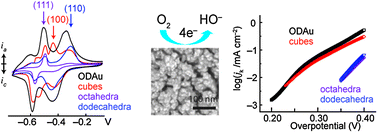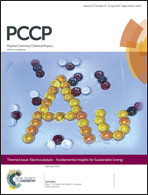Alkaline O2 reduction on oxide-derived Au: high activity and 4e− selectivity without (100) facets†
Abstract
Gold films produced from gold oxide precursors (“oxide-derived Au”) were compared to polyhedral Au nanoparticles for electrocatalytic alkaline O2 reduction. Despite having no detectable abundance of (100) facets, oxide-derived Au exhibited 4e− selectivity and surface-area-normalized activity that rivaled cubic Au nanoparticles with high (100) abundance. The activity of oxide-derived Au likely arises from active sites at the surface terminations of defects that are trapped during gold oxide reduction.

- This article is part of the themed collection: Electrocatalysis - Fundamental Insights for Sustainable Energy

 Please wait while we load your content...
Please wait while we load your content...